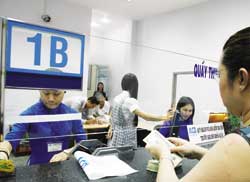Government moves to rein in dollarisation
The State Bank’s tightened dollar lending regulations may allow it to kill two birds with one stone. With the Decision 09/2008/QD-NHNN coming into effect from April 25, 2008 after a seven-month study, customers are now permitted to borrow dollars from commercial banks for three purposes instead of the previous eight.
 Inflationary pressures are turning the screw on the economy |
According to an International Monetary Fund’s rating, if foreign currency deposits in the total money supply (FCD/M2) of any economy exceeds 30 per cent, it means the economy is in dollarisation. In Vietnam, the ratio, after peaking at 41.2 per cent in 1991 due to hyper inflation, has been fluctuating between 20-30 per cent.
“This tightening is just the State Bank’s first step toward the abolishment of foreign currency credit in Vietnam’s banking system as the coexistence of dollar and dong interest rates has caused difficulties to the State Bank’s monetary management,” said the State Bank source.
Generally, in a dollarisation economy, controlling credit growth could be more difficult. The central bank’s tools such as raising reserve requirements and issuing central bank notes to withdraw money from circulation are just as effective to control local currency credit.
In response to the dollarisation issue, the prime minister worked out Decision 98/2007/QD-TTg dated July 4, 2007 requesting relevant authorities to reduce the economy’s dollarisation level. “Additionally, the decision to cap foreign currency credit growth has been attributed to total credit growth, a major drive to push the consumer price index (CPI) increase,” said the State Bank official.
According to a Vietcombank source, previously, local banks had two channels for using the dollar. These were lending to domestic enterprises and depositing at overseas banks enjoying an interest rate margin.
In the past, local banks’ dollar deposits at overseas banks sometimes hit $4 billion. However, over the last two years, with dollar rates continuously increasing and deposit interest rates being reduced overseas, local banks have had only one channel to lend to domestic customers.
“That’s why dollar credit growth has surpassed credit growth recently,” said the Vietcombank source.
Banking experts said that the high demand for the greenback was partly due to companies borrowing short-term dollars at better rates compared to the dong.
At present, the short-term dollar lending rates were around 9 per cent per year, while the dong rates were around 16 per cent for short-term loans and even 18-20 per cent for long-term loans. HSBC Asia economist Prakriti Sofat said the move would help curb credit growth and reduce the inflationary pressure on the economy.
Last year, Vietnam’s credit growth hit 53 per cent and was considered a major factor leading to its record annual CPI increase of 12.63 per cent.
What the stars mean:
★ Poor ★ ★ Promising ★★★ Good ★★★★ Very good ★★★★★ Exceptional
Latest News
More News
- Tax sector wraps up 2025 and sets priorities for next year (December 25, 2025 | 14:00)
- A tipping point for digital and hybrid wealth management in Vietnam (December 23, 2025 | 13:33)
- $250 million deal targets women-owned SMEs, sustainable agriculture (December 22, 2025 | 17:40)
- Stock market posts resilient 2025 performance (December 19, 2025 | 18:17)
- Citi Vietnam receives 2025 AmCham CSR recognition (December 19, 2025 | 16:35)
- As global green supply chain reshapes, will Vietnam be left behind? (December 19, 2025 | 08:00)
- Banks gear up for massive capital increases (December 18, 2025 | 17:04)
- Securing capital and efficiency for Vietnam’s 2026-2030 growth ambitions (December 17, 2025 | 10:00)
- Energy sector in need of blended finance mechanisms (December 17, 2025 | 09:00)
- Vietnam still has room to mobilise capital for sustainable growth (December 17, 2025 | 08:57)

















 Mobile Version
Mobile Version